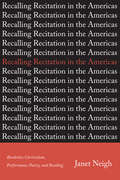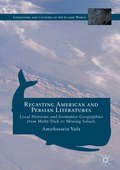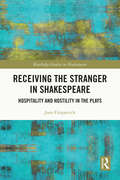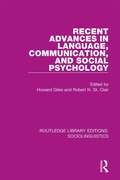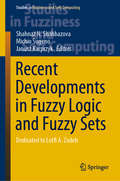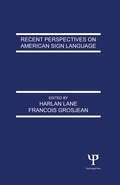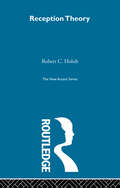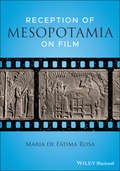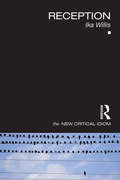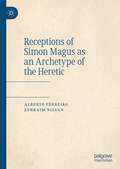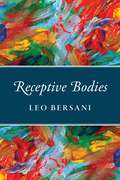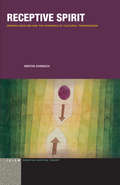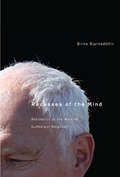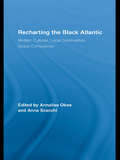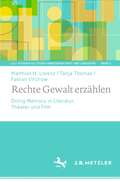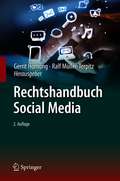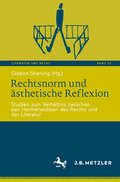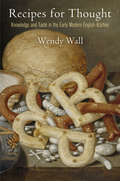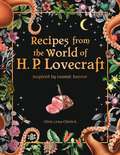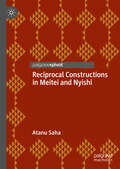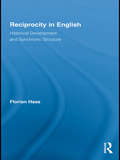- Table View
- List View
Recalling Recitation in the Americas: Borderless Curriculum, Performance Poetry, and Reading
by Janet NeighSpoken word is one of the most popular styles of poetry in North America. While its prevalence is often attributed to the form’s strong ties to oral culture, Recalling Recitation in the Americas reveals how poetry memorization and recitation curricula, shaped by British Imperial policy, influenced contemporary performance practices. During the early twentieth century, educators frequently used the recitation of canonical poems to instill "proper" speech and behaviour in classrooms in Canada, the Caribbean, and the United States. Janet Neigh critically analyses three celebrated performance poets - E. Pauline Johnson-Tekahionwake (1861-1913), Langston Hughes (1902-1967), and Louise Bennett (1919-2006) - who refashioned recitation to cultivate linguistic diversity and to resist its disciplinary force. Through an examination of the dialogues among their poetic projects, Neigh illuminates how their complicated legacies as national icons obscure their similar approaches to resisting Anglicization. Recalling Recitation in the Americas focuses on the unexplored relationship between education history and literary form and establishes the far-reaching effects of poetry memorization and recitation on the development of modern performance poetry in North America.
Recapturing the Oval Office: New Historical Approaches to the American Presidency
by Bruce J. Schulman Brian BaloghSeveral generations of historians figuratively abandoned the Oval Office as the bastion of out-of-fashion stories of great men. And now, decades later, the historical analysis of the American presidency remains on the outskirts of historical scholarship, even as policy and political history have rebounded within the academy. In Recapturing the Oval Office, leading historians and social scientists forge an agenda for returning the study of the presidency to the mainstream practice of history and they chart how the study of the presidency can be integrated into historical narratives that combine rich analyses of political, social, and cultural history. The authors demonstrate how "bringing the presidency back in" can deepen understanding of crucial questions regarding race relations, religion, and political economy. The contributors illuminate the conditions that have both empowered and limited past presidents, and thus show how social, cultural, and political contexts matter. By making the history of the presidency a serious part of the scholarly agenda in the future, historians have the opportunity to influence debates about the proper role of the president today. Contributors: Brian Balogh, University of Virginia; Michael A. Bernstein, Tulane University; Kathryn Cramer Brownell, Purdue University; N. D. B. Connolly, The Johns Hopkins University; Frank Costigliola, University of Connecticut; Gareth Davies, University of Oxford; Darren Dochuk, Washington University; Susan J. Douglas, University of Michigan; Daniel J. Galvin, Northwestern University; William I. Hitchcock, University of Virginia; Cathie Jo Martin, Boston University; Alice O'Connor, University of California, Santa Barbara; Bruce J. Schulman, Boston University; Robert O. Self, Brown University; Stephen Skowronek, Yale University
Recasting American and Persian Literatures
by Amirhossein VafaReading literary and cinematic events between and beyond American and Persian literatures, this book questions the dominant geography of the East-West divide, which charts the global circulation of texts as World Literature. Beyond the limits of national literary historiography, and neocolonial cartography of world literary discourse, the minor character Parsee Fedallah in Herman Melville's Moby-Dick (1851) is a messenger who travels from the margins of the American literature canon to his Persian literary counterparts in contemporary Iranian fiction and film, above all, the rural woman Mergan in Mahmoud Dowlatabadi's novel Missing Soluch (1980). In contention with Eurocentric treatments of world literatures, and in recognition of efforts to recast the worldliness of American and Persian literatures, this book maintains that aesthetic properties are embedded in their local histories and formative geographies.
Receiving the Stranger in Shakespeare: Hospitality and Hostility in the Plays (Routledge Studies in Shakespeare)
by Joan FitzpatrickHospitality to strangers has become an increasingly prevalent topic in recent years, from political upheavals resulting in the displacement of millions of people, to the emergence of our collective obligations towards strangers during the Covid-19 pandemic. Yet the vexed question of when to welcome or reject strangers is nothing new. In the context of an increasingly multicultural early modern London, where disease, including plague, was often rampant, Shakespeare repeatedly explores the subtle ethical complexities that attend seemingly straightforward acts of hospitality or their refusal. Receiving the Stranger in Shakespeare provides critical analysis of the most important moments of hospitality or its denial in Shakespeare’s plays, situating them historically in order to fully explore Shakespeare's engagement with early modern views. The book explores the plays definitions of the self, self-interest, and otherness and their relevance to make sense of the world, and an exploration of the social, economic, and political particularities that make such distinctions as troublesome as they are necessary. This volume will unravel the various attempts, successful and unsuccessful, to balance these obligations and risks.
Recent Advances in Language, Communication, and Social Psychology (Routledge Library Editions: Sociolinguistics)
by Howard Giles Robert N. St. ClairOriginally published in 1985. Detailed exploration of the dynamics of language within social psychology forms a social psychology of language which is distinct from other approaches. This volume presents some of the growing body of research in this area, with many theoretical models and ideas - chapters consider the relationship between language and social situations, looking at cognitive structures in how communication between individuals develops in childhood and beyond, how it defines social situations, influences others, expresses feelings and values, evokes social categorizations and how it can break down.
Recent Developments in Fuzzy Logic and Fuzzy Sets: Dedicated to Lotfi A. Zadeh (Studies in Fuzziness and Soft Computing #391)
by Janusz Kacprzyk Shahnaz N. Shahbazova Michio SugenoThis book provides a timely and comprehensive overview of current theories and methods in fuzzy logic, as well as relevant applications in a variety of fields of science and technology. Dedicated to Lotfi A. Zadeh on his one year death anniversary, the book goes beyond a pure commemorative text. Yet, it offers a fresh perspective on a number of relevant topics, such as computing with words, theory of perceptions, possibility theory, and decision-making in a fuzzy environment. Written by Zadeh’s closest colleagues and friends, the different chapters are intended both as a timely reference guide and a source of inspiration for scientists, developers and researchers who have been dealing with fuzzy sets or would like to learn more about their potential for their future research.
Recent Perspectives on American Sign Language
by Francois Grosjean Harlan L. LanePublished in 1989, Recent Perspectives on American Sign Language is a valuable contribution to the field of Cognitive Psychology.
Reception Theory: A Critical Introduction (New Accents)
by Robert C. HolubFirst published in 2002. Routledge is an imprint of Taylor & Francis, an informa company.
Reception of Mesopotamia on Film
by Maria de Fatima RosaExplore an insightful account of the reception of Mesopotamia in modern cinema In Reception of Mesopotamia on Film, Dr. Maria de Fátima Rosa explores how the Ancient Mesopotamian civilization was portrayed by the movie industry, especially in America and Italy, and how it was used to convey analogies between ancient and contemporary cultural and moral contexts. Spanning a period that stretches from the beginning of the 20th century to the present day, the book explores how the Assyrian and Babylonian elites, particularly kings, queens, and priestesses, were perceived and represented on screen by filmmakers. A focus on the role played by Ancient Near Eastern women and on the polytheistic religion practiced in the land between the rivers will be provided. This book also offers an insightful interpretation of the bias message that most of these films portray and how the Mesopotamian past and Antiquity brought to light and stimulated the debate on emerging 20th century political and social issues. The book also offers: A thorough introduction to the Old Testament paradigm and the romanticism of classical authors A comprehensive exploration of the literary reception of the Mesopotamian legacy and its staging Practical discussions of the rediscovery, appropriation, and visual reproduction of Assyria and Babylonia In-depth examinations of cinematic genres and cinematographic contexts Perfect for students of the history of antiquity and cinematographic history, Reception of Mesopotamia on Film is also an invaluable resource for anyone with an interest in reception studies.
Reception: Lucan And Vergil As Theorists Of Politics And Space (The New Critical Idiom #4)
by Ika WillisReception introduces students and academics alike to the study of the way in which texts are received by readers, viewers, and audiences. Organized conceptually and thematically, this book provides a much-needed overview of the field, drawing on work in literary and cultural studies as well as Classics, Biblical studies, medievalism, and the media history of the book. It provides new ways of understanding and configuring the relationships between the various terminologies and theories that comprise reception study, and suggests potential ways forward for study and research in the light of such new configurations. Written in a clear and accessible style, this is the ideal introduction to the study of reception.
Receptions of Simon Magus as an Archetype of the Heretic
by Ephraim Nissan Alberto FerreiroThis book about receptions of Simon Magus uncovers further facets of one who was held to be the evil archetype of heretics. Ephraim Nissan and Alberto Ferreiro explore how Simon Magus has been represented in text, visual art, and music. Special attention is devoted to the late medieval Catalan painter Lluís Borrassà and the Italian librettist and musician Arrigo Boito. The tradition of Simon Magus’ demonic flight, ending in his crashing down, first appears in the patristic literature. The book situates that flight typologically across cultures. Fascinating observations emerge, as the discussion spans flight of the wicked in rabbinic texts, flight and death of King Lear’s father and a Soviet-era Buryat Buddhist monk, flight and doom of the fool in an early modern German broadsheet, and more. The book explains and moves beyond extant scholarly wisdom on how the polemic against Mani (the founder of Manichaeism) was tinged with hues of Simon Magus. The novelty of this book is that it shows that Simon Magus’ receptions teach us a great deal about the contexts in which this archetype was deployed.
Receptive Bodies
by Leo BersaniLeo Bersani, known for his provocative interrogations of psychoanalysis, sexuality, and the human body, centers his latest book on a surprisingly simple image: a newborn baby simultaneously crying out and drawing its first breath. These twin ideas—absorption and expulsion, the intake of physical and emotional nourishment and the exhalation of breath—form the backbone of Receptive Bodies, a thoughtful new essay collection. These titular bodies range from fetuses in utero to fully eroticized adults, all the way to celestial giants floating in space. Bersani illustrates his exploration of the body’s capacities to receive and resist what is ostensibly alien using a typically eclectic set of sources, from literary icons like Marquis de Sade to cinematic provocateurs such as Bruno Dumont and Lars von Trier. This sharp and wide-ranging book will excite scholars of Freud, Foucault, and film studies, or anyone who has ever stopped to ponder the give and take of human corporeality.
Receptive Spirit: German Idealism and the Dynamics of Cultural Transmission (Idiom: Inventing Writing Theory)
by Márton DornbachPremised on the assumption that the mind is fundamentally active and self-determining, the German Idealist project gave rise to new ways of thinking about our dependence upon culturally transmitted models of thought, feeling, and creativity. Receptive Spirit elucidates the ways in which Kant, Fichte, Schlegel, and Hegel envisioned and enacted the conjunction of receptivity and spontaneous activity in the transmission of human-made models of mindedness. Their innovations have defined the very terms in which we think about the historical character of aesthetic experience, the development of philosophical thinking, the dynamics of textual communication, and the task of literary criticism.Combining a reconstructive approach to this key juncture of modern thought with close attention paid to subsequent developments, Marton Dornbach argues that we must continue to think within the framework established by the Idealists if we are to keep our bearings in the contemporary intellectual landscape.
Recesses of the Mind
by Birna BjarnadóttirRecesses of the Mind explores Guðbergur Bergsson's aesthetics of life and literature. Bergsson - like so many writers whose language is not widely spoken or read - is scarcely known outside his homeland, but the psychological depth of his vision reveals the minds of his characters in ways that are reminiscent of novelists such as Hamsun, Faulkner, and Garcia Márquez. Birna Bjarnadóttir constructs a deep and comprehensive argument for Bergsson's significance as a master of narrative. Crossing centuries, oceans, and continents, her contextualization of Bergsson's aesthetics stretches from his native land's literary tradition to the cultural domains of Europe and North and South America. Her investigation of his ideas on beauty, love, and belief, presented as a dialogue between Bergsson and numerous other writers and philosophers - Plotinus, Augustine, Nietzsche, Kierkegaard, Blanchot - is a striking reflection on some of the most important questions of modern times. Recesses of the Mind introduces a profound writer to the international stage. The book's exploration of the cultural periphery is equally significant, suggesting new interpretative strategies for considering cultural contributions from isolated places.
Recesses of the Mind: Aesthetics in the Work of Guðbergur Bergsson
by Birna BjarnadóttirBirna Bjarnadóttir constructs a deep and comprehensive argument for Bergsson's significance as a master of narrative. Crossing centuries, oceans, and continents, her contextualization of Bergsson's aesthetics stretches from his native land's literary tradition to the cultural domains of Europe and North and South America. Her investigation of his ideas on beauty, love, and belief, presented as a dialogue between Bergsson and numerous other writers and philosophers - Plotinus, Augustine, Nietzsche, Kierkegaard, Blanchot - is a striking reflection on some of the most important questions of modern times. Recesses of the Mind introduces a profound writer to the international stage. The book's exploration of the cultural periphery is equally significant, suggesting new interpretative strategies for considering cultural contributions from isolated places.
Recharting the Black Atlantic: Modern Cultures, Local Communities, Global Connections (Routledge Research in Atlantic Studies #1)
by Annalisa Oboe Anna ScacchiThis book focuses on the migrations and metamorphoses of black bodies, practices, and discourses around the Atlantic, particularly with regard to current issues such as questions of identity, political and human rights, cosmopolitics, and mnemo-history.
Recht richtig formulieren: Ein Handbuch mit Beispielen aus der journalistischen Praxis (Journalistische Praxis)
by Frank BräutigamJede Journalistin, jeder Journalist berichtet früher oder später über rechtliche Themen. Zum Beispiel über den Mordprozess am Landgericht vor Ort, das neuste Ermittlungsverfahren gegen einen Lokalpolitiker oder das umstrittene Verbot einer Demonstration. Dieses Buch beschreibt typische Situationen aus dem journalistischen Alltag. Es hilft dabei, Fehler und Ungenauigkeiten zu vermeiden. Geht der Angeklagte jetzt in "Berufung" oder "Revision"? Wurde der Verdächtige "festgenommen" oder "verhaftet"? Es benennt die typischen Fallstricke beim Thema "Recht", erklärt kurz die relevanten Begriffe und macht konkrete Vorschläge, wie man Recht richtig formuliert. Auch Autorinnen und Autoren von Krimi-Drehbüchern bekommen zahlreiche Hinweise, mit denen sie typische Fehler vermeiden können.
Rechte Gewalt erzählen: Doing Memory in Literatur, Theater und Film (LiLi: Studien zu Literaturwissenschaft und Linguistik #1)
by Matthias N. Lorenz Fabian Virchow Tanja ThomasRechte Gewalt, die in der Bundesrepublik Anfang der 1990er Jahre Konjunktur hatte und in den letzten Jahren abermals stark angestiegen ist, ist bis heute nur äußerst lückenhaft aufgearbeitet und wird künstlerisch kaum erinnert. Wenn überhaupt, herrschen Täterperspektiven im Rahmen eines rein ‚weißen‘ Erinnerungsrahmens vor, die Stimmen der Opfer bleiben ungehört. Ausgehend von der Beobachtung, dass mit der gesellschaftlichen Missachtung dieser Gewalt eine zweite Traumatisierung stattfindet, fragt der Band nach Formen, Leistungen und Defiziten der dokumentarischen wie fiktionalen Aufarbeitung rechter Gewalt in Literatur, Theater und Film. Die erzählenden Künste werden in den untersuchten Beispielen sowohl auf ihren Beitrag zu dem beobachteten Missstand als auch hinsichtlich ihres Potentials zu dessen Überwindung untersucht.Mit Beiträgen von Svea Bräunert, Anna Brod, Gabriele Fischer, Hans-Joachim Hahn, Matthias N. Lorenz, Jonas Meurer, Dan Thy Nguyen, Corinna Schlicht, Sebastian Schweer, Tanja Thomas, Fabian Virchow, Johanna Vollmeyer und Stefan Winterstein.
Rechtshandbuch Social Media
by Gerrit Hornung Ralf Müller-TerpitzSeit der Entwicklung des Internets zum Web 2.0 sind Social Media aus unserem privaten und beruflichen Alltag nicht mehr wegzudenken. Dienste wie Facebook, Instagram, YouTube, Twitter, WhatsApp, berufliche Netzwerke oder Plattformen für Bewertungen und Blogs haben erhebliche praktische Bedeutung erlangt und werfen zahlreiche, oft ungeklärte oder im Fluss befindliche Rechtsfragen auf. Seit dem Erscheinen der 1. Auflage dieses Handbuchs im Jahre 2015 hat sich zudem der Gesetzgeber dem Phänomen Social Media verstärkt angenommen. Die nunmehr aktualisierte und erweiterte 2. Auflage geht mit wissenschaftlichem Anspruch bei gleichzeitiger Praxisorientierung systematisch auf Rechtsfragen ein, die mit der Nutzung sozialer Netzwerke zusammenhängen. In Gestalt der klassischen Rechtsgebiete des Schuldrechts, Strafrechts, Arbeitsrechts und des Persönlichkeitsschutzes, der neueren Rechtsbereiche des Datenschutzes und E-Governments bis hin zum spezifischen Medien- und Internetrecht sowie unter Einschluss der Kommunikationswissenschaften wird das Phänomen Social Media ganzheitlich erfasst. Abgerundet werden diese Betrachtungen nunmehr durch Beiträge zu den ökonomischen Grundlagen sowie zum wettbewerbsrechtlichen Rahmen der sozialen Medien.
Rechtsnorm und ästhetische Reflexion: Studien zum Verhältnis zwischen den Hermeneutiken des Rechts und der Literatur (Literatur und Recht #13)
by Gideon StieningDer Band versammelt Studien zur juristischen und zur literarischen Hermeneutik sowie zu deren Verhältnis. Auf der Grundlage philosophischer und theologischer Konzepte zum Verstehen und zur Interpretation von Texten werden die Besonderheiten der Auslegung von Recht und Literatur erörtert. Die spezielle Herausforderung besteht in der Korrelation der spezifisch juristischen und spezifisch literarischen Kunst der Auslegung. Berücksichtigt werden zudem der historische Wandel dieser Bereichshermeneutiken und deren Verhältnis zueinander.
Recipes for Thought
by Wendy WallFor a significant part of the early modern period, England was the most active site of recipe publication in Europe and the only country in which recipes were explicitly addressed to housewives. Recipes for Thought analyzes, for the first time, the full range of English manuscript and printed recipe collections produced over the course of two centuries.Recipes reveal much more than the history of puddings and pies: they expose the unexpectedly therapeutic, literate, and experimental culture of the English kitchen. Wendy Wall explores ways that recipe writing--like poetry and artisanal culture--wrestled with the physical and metaphysical puzzles at the center of both traditional humanistic and emerging "scientific" cultures. Drawing on the works of Shakespeare, Spenser, Jonson, and others to interpret a reputedly "unlearned" form of literature, she demonstrates that people from across the social spectrum concocted poetic exercises of wit, experimented with unusual and sometimes edible forms of literacy, and tested theories of knowledge as they wrote about healing and baking. Recipe exchange, we discover, invited early modern housewives to contemplate the complex components of being a Renaissance "maker" and thus to reflect on lofty concepts such as figuration, natural philosophy, national identity, status, mortality, memory, epistemology, truth-telling, and matter itself. Kitchen work, recipes tell us, engaged vital creative and intellectual labors.
Recipes from the World of H.P Lovecraft: Recipes inspired by cosmic horror
by Olivia Luna EldritchImmerse yourself in the black seas of infinity that is Lovecraft's World like never before with these diverse cuisines inspired by its places, characters and a pantheon of alien deities.The H.P. Lovecraft Cookbook is bursting with photos of many of the recipes, along with extraordinary illustrations and extracts from the original tales. This book offers something for everyone: featuring easy to prepare vegan, vegetarian and seafood dishes, that are delicious enough to wake the tentacled Elder God Cthulhu from his slumber with ingredients readily found on our world.So go ahead, journey through Arkham all the way to R'lyeh while you prepare a banquet fit for the Ancient Ones with recipes that capture the piquancy of Lovecraft's most vivid tales.
Recipes from the World of H.P Lovecraft: Recipes inspired by cosmic horror
by Olivia Luna EldritchImmerse yourself in the black seas of infinity that is Lovecraft's World like never before with these diverse cuisines inspired by its places, characters and a pantheon of alien deities.The H.P. Lovecraft Cookbook is bursting with photos of many of the recipes, along with extraordinary illustrations and extracts from the original tales. This book offers something for everyone: featuring easy to prepare vegan, vegetarian and seafood dishes, that are delicious enough to wake the tentacled Elder God Cthulhu from his slumber with ingredients readily found on our world.So go ahead, journey through Arkham all the way to R'lyeh while you prepare a banquet fit for the Ancient Ones with recipes that capture the piquancy of Lovecraft's most vivid tales.
Reciprocal Constructions in Meitei and Nyishi
by Atanu SahaThis book investigates three interesting questions arising from the intriguing cross-linguistic perspective of Meiteilon and Nyishi, two Tibeto-Burman languages respectively spoken in the states of Manipur and Arunachal Pradesh in India. The first question relates to developing a model for the syntax and semantics of these verbal reciprocal languages. Secondly, the book attempts to provide an account of the surface variations between the languages using this model. The book also tries to build an account for the co-occurrences of the nominal and verbal reciprocals in languages like Meiteilon and Nyishi. Both languages use a verbal strategy for default reciprocalization and both the languages show discontinuous reciprocity. The author argues that if the reciprocal marker consists of one suffix (as in the case of Meiteilon), it may express several other functions, but if the reciprocal marker composes of more than one suffix (as in Nyishi), it does not show polysemy. Both languages can reciprocalize unaccusative and unergative verbs, and in both the languages, overt distributive nominal reciprocal markers show strong reciprocity. This book will be of interest to syntacticians and typologists working in the domain of universal grammar, as well as computational linguists seeking empirical data on endangered and underrepresented languages.
Reciprocity in English: Historical Development and Synchronic Structure (Routledge Studies In Germanic Linguistics #15)
by Florian HaasAlthough the grammatical expression of reciprocal (or ‘mutual’) situations in the languages of the world has received a surprising amount of attention in recent years, so far no comprehensive study specifically dealing with the historical development and synchronic structure of English reciprocal constructions has been published. This book takes into consideration insights from the three major research projects on reciprocity in the languages of the world as well as the rich literature on more specific aspects of reciprocity. Assuming a usage-based model of grammar, the development of the reciprocal strategies used in present-day English is described, with special attention paid to the periods following Middle English, where today’s system began to take shape. The means of expressing reciprocity in today’s English (e.g. the expressions each other and one another) are then analyzed as a system of competing constructions, the make-up and distribution of which can be related both to their history and subtle distinctions in meaning and use associated with the different constructions. Quantitative data from corpora of natural language provides evidence for the analyses put forward. Wherever possible, claims on the expression of reciprocity in present-day English are checked against what is known about the grammar of reciprocity in other languages.
